The Stock Market Correction that has Failed to Materialise
Stock-Markets / Stock Index Trading May 31, 2009 - 01:11 PM GMTBy: Mike_Burk
 The good news is: The NASDAQ composite (OTC) finished at a multi month high last Friday and all of the NASDAQ summation indices (SI's) turned upward.
The good news is: The NASDAQ composite (OTC) finished at a multi month high last Friday and all of the NASDAQ summation indices (SI's) turned upward.
Short Term
For a new high indicator on both the NYSE and NASDAQ, I use a 10% trend (19 day EMA) of new highs as reported by those exchanges. The NASDAQ new high indicator (OTC NH) works pretty well as a short term indicator. If the indicator continues to move upward on down days you are usually in a strong market and if the indicator moves downward on up days you are usually looking at a weak market. I have been suspicious of this indicator recently because the numbers are so small (current value = 23), but it appears to be working.
The chart below covers the past 3 months showing the OTC in blue and the OTC NH in green. Dashed vertical lines have been drawn on the 1st trading day of each week and darker vertical lines have been drawn on the 1st trading day of each month.
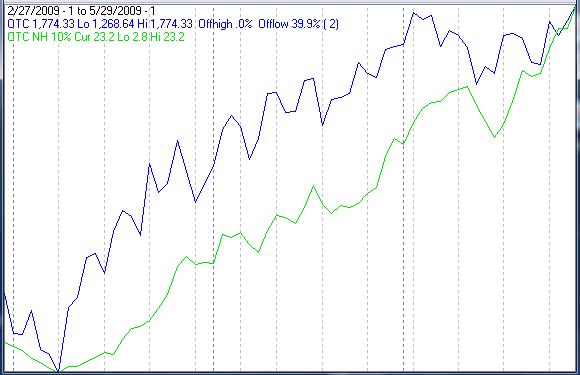
The indicator finished the week at a new cycle high and was up last Tuesday, a decisively down day.
Intermediate term
On March 6 there were 827 new lows on the NYSE and 567 on the NASDAQ. Those numbers are big enough to suggest a high likelihood of a retest of the March 9 lows.
I have been looking for a developing top pattern where, after leading the way up, the secondaries would deteriorate faster than the blue chips in a pull back then lag the blue chips as they (the blue chips) went to new highs. After getting off to a promising start, that pattern is failing to develop.
From the early May highs the indices fell with secondaries represented by the Russell 2000 (R2K) leading the way downward and the blue chips represented by the S&P 500 (SPX) holding up the best. For the scenario to properly complete itself the SPX would go to new cycle highs while the R2K lagged. That is not the way it has played out.
The table below shows the amount each index declined from its early May high and the amount it has recovered since its mid May low.
| Index | Decline from early May high |
Advance from mid May low |
| SPX | 4.9% | 4.1% |
| MID (S&P mid cap) | 7.5% | 6.0% |
| OTC | 5.6% | 6.6% |
R2K |
7.8% |
6.3% |
The secondaries have been leading the way upward and all of the major indices are within 2% of their early May highs so the recent advance is likely to continue.
Seasonality
Next week includes the first 5 trading days of June during the 1st year of the Presidential Cycle.
The tables show the daily return on a percentage basis for the first 5 trading days of June during the 1st year of the Presidential Cycle. OTC data covers the period from 1963 - 2008 and SPX data from 1928 - 2008. There are summaries for both the 1st year of the Presidential Cycle and all years combined.
The week has, on average, shown modest gains over all periods.
First 5 days of June.
The number following the year represents its position in the presidential cycle.
The number following the daily return represents the day of the week;
1 = Monday, 2 = Tuesday etc.
| OTC Presidential Year 1 | ||||||
| Day1 | Day2 | Day3 | Day4 | Day5 | Totals | |
| 1965-1 | 0.40% 2 | -1.17% 3 | -0.50% 4 | -0.38% 5 | 0.14% 1 | -1.52% |
| 1969-1 | 0.28% 1 | -0.49% 2 | -0.15% 3 | -0.52% 4 | 0.44% 5 | -0.45% |
| 1973-1 | -0.33% 5 | -1.50% 1 | 0.93% 2 | -0.01% 3 | 0.86% 4 | -0.05% |
| 1977-1 | 0.28% 3 | -0.06% 4 | 0.41% 5 | -0.08% 1 | 0.06% 2 | 0.61% |
| 1981-1 | -0.20% 1 | -1.54% 2 | -0.32% 3 | 0.36% 4 | 0.74% 5 | -0.96% |
| 1985-1 | -0.07% 1 | 0.14% 2 | 0.27% 3 | 0.03% 4 | -0.28% 5 | 0.08% |
| Avg | -0.01% | -0.69% | 0.23% | -0.05% | 0.36% | -0.15% |
| 1989-1 | 0.48% 4 | 0.74% 5 | -0.84% 1 | 0.03% 2 | 0.95% 3 | 1.35% |
| 1993-1 | 0.54% 2 | 0.22% 3 | 0.05% 4 | -0.60% 5 | -1.05% 1 | -0.84% |
| 1997-1 | 0.32% 1 | -1.42% 2 | -0.38% 3 | 0.75% 4 | 1.06% 5 | 0.34% |
| 2001-1 | 1.84% 5 | 0.30% 1 | 3.61% 2 | -0.72% 3 | 2.09% 4 | 7.13% |
| 2005-1 | 0.95% 3 | 0.48% 4 | -1.26% 5 | 0.21% 1 | -0.41% 2 | -0.04% |
| Avg | 0.83% | 0.06% | 0.24% | -0.06% | 0.52% | 1.59% |
| OTC summary for Presidential Year 1 1965 - 2005 | ||||||
| Averages | 0.41% | -0.39% | 0.17% | -0.09% | 0.42% | 0.51% |
| % Winners | 73% | 45% | 45% | 45% | 73% | 45% |
| MDD 6/3/1981 2.05% -- 6/4/1965 2.05% -- 6/4/1973 1.82% | ||||||
| OTC summary for all years 1963 - 2008 | ||||||
| Averages | 0.25% | 0.34% | 0.20% | 0.09% | 0.05% | 0.91% |
| % Winners | 60% | 70% | 61% | 57% | 52% | 63% |
| MDD 6/7/2002 4.97% -- 6/6/1967 3.90% -- 6/7/2006 3.07% | ||||||
| SPX Presidential Year 1 | ||||||
| Day1 | Day2 | Day3 | Day4 | Day5 | Totals | |
| 1929-1 | 0.36% 6 | 1.40% 1 | 1.46% 2 | -0.20% 3 | 0.20% 4 | 3.23% |
| 1933-1 | 1.04% 4 | 4.00% 5 | -2.76% 6 | 2.23% 1 | -0.30% 2 | 4.21% |
| 1937-1 | -1.85% 2 | 0.69% 3 | 0.19% 4 | 1.12% 5 | -0.18% 6 | -0.04% |
| 1941-1 | 0.11% 1 | 1.18% 2 | -0.11% 3 | 0.42% 4 | -0.11% 5 | 1.49% |
| 1945-1 | 0.13% 5 | 0.20% 6 | -0.07% 1 | -0.13% 2 | -0.47% 3 | -0.33% |
| Avg | -0.04% | 1.49% | -0.26% | 0.69% | -0.17% | 1.71% |
| 1949-1 | -0.35% 3 | 0.00% 4 | -0.64% 5 | -1.64% 1 | 0.14% 2 | -2.48% |
| 1953-1 | -1.59% 1 | 0.29% 2 | -0.17% 3 | -0.62% 4 | 0.25% 5 | -1.84% |
| 1957-1 | -0.13% 1 | -0.19% 2 | -0.02% 3 | 0.70% 4 | 0.11% 5 | 0.47% |
| 1961-1 | 0.00% 4 | 0.26% 5 | 0.52% 1 | -0.28% 2 | -0.37% 3 | 0.12% |
| 1965-1 | -0.79% 2 | -0.72% 3 | -0.22% 4 | 0.24% 5 | -0.26% 1 | -1.75% |
| Avg | -0.57% | -0.07% | -0.10% | -0.32% | -0.03% | -1.10% |
| 1969-1 | -0.50% 1 | -0.30% 2 | -0.04% 3 | 0.17% 4 | -0.62% 5 | -1.30% |
| 1973-1 | -0.97% 5 | -0.92% 1 | 1.60% 2 | -0.30% 3 | 1.47% 4 | 0.88% |
| 1977-1 | 0.84% 3 | -0.20% 4 | 0.98% 5 | -0.47% 1 | 0.51% 2 | 1.67% |
| 1981-1 | -0.14% 1 | -1.35% 2 | 0.07% 3 | 0.19% 4 | 0.96% 5 | -0.27% |
| 1985-1 | -0.12% 1 | 0.38% 2 | 0.06% 3 | 0.47% 4 | -0.72% 5 | 0.07% |
| Avg | -0.18% | -0.48% | 0.54% | 0.01% | 0.32% | 0.21% |
| 1989-1 | 0.45% 4 | 1.10% 5 | -1.07% 1 | 0.69% 2 | 0.84% 3 | 2.00% |
| 1993-1 | 0.81% 2 | 0.00% 3 | -0.30% 4 | -0.54% 5 | -0.53% 1 | -0.55% |
| 1997-1 | -0.23% 1 | -0.10% 2 | -0.63% 3 | 0.39% 4 | 1.73% 5 | 1.16% |
| 2001-1 | 0.39% 5 | 0.51% 1 | 1.30% 2 | -1.05% 3 | 0.55% 4 | 1.69% |
| 2005-1 | 0.90% 3 | 0.17% 4 | -0.69% 5 | 0.12% 1 | -0.02% 2 | 0.49% |
| Avg | 0.46% | 0.34% | -0.28% | -0.08% | 0.51% | 0.96% |
| SPX summary for Presidential Year 1 1929 - 2005 | ||||||
| Averages | -0.08% | 0.32% | -0.03% | 0.08% | 0.16% | 0.45% |
| % Winners | 45% | 60% | 40% | 55% | 50% | 60% |
| MDD 6/3/1933 2.76% -- 6/6/1949 2.61% -- 6/4/1953 2.08% | ||||||
| SPX summary for all years 1928 - 2008 | ||||||
| Averages | 0.01% | 0.19% | 0.24% | 0.23% | -0.01% | 0.64% |
| % Winners | 51% | 62% | 53% | 53% | 51% | 59% |
| MDD 6/2/1931 6.30% -- 6/6/1930 3.96% -- 6/4/1962 3.96% | ||||||
Money supply (M2)
The chart below was provided by Gordon Harms. Money supply growth turned up slightly from its lowest level in years.
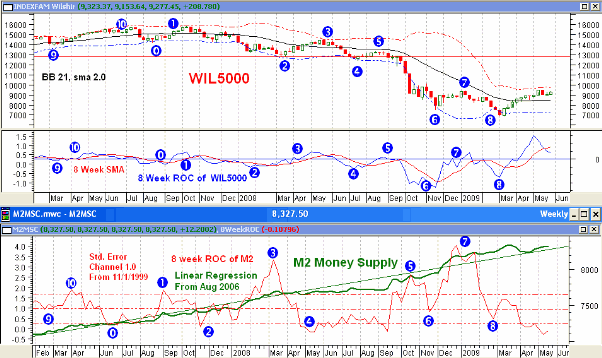
June
Since 1963, over all years the OTC in June has had on average the 9th highest return, up 52% of the time with an average return of 0.3%. However, during the 1st year of the Presidential Cycle June has been second only to February as the worst month of the year up only 36% of the time with an average loss of 1.5%.
The average month has 21 trading days. The chart below has been calculated by averaging the daily percentage change of the OTC for each of the 1st 11 trading days and each of the last 10. In months when there were more than 21 trading days some of the days in the middle were not counted. In months when there were less than 21 trading days some of the days in the middle of the month were counted twice. Dashed vertical lines have been drawn after the 1st trading day and at 5 trading day intervals after that. The line is solid on the 11th trading day, the dividing point.
The blue line shows the average of the OTC over all years since 1963 while the green line shows the average during the 1st year of the Presidential Cycle.

Since 1928 the SPX has been up 53% of the time in June with an average gain of 0.9% making is the 5th best month of the year. During the 1st year of the Presidential Cycle the SPX has been up 42% of the time with an average gain of 0.8% putting 4th in the monthly performance figures.
The chart below is similar to the one above except it shows the daily performance over all years of the SPX in May in red and the performance during the 1st year of the Presidential Cycle in green.
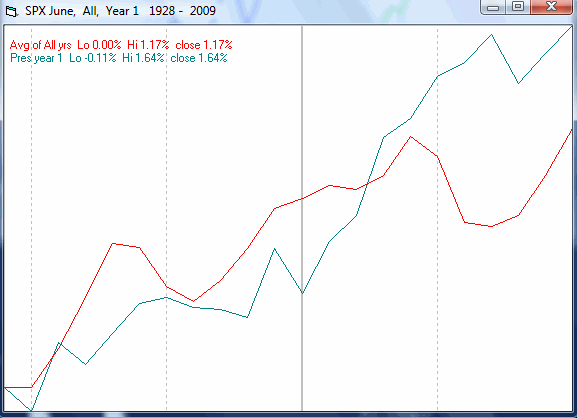
There is a huge difference between the OTC and SPX charts for June. A 10.8% gain in 1929 and a 12.0% gain in 1933 that skew the numbers positively for the 1st year of the Presidential Cycle, a 19.6% gain in 1931, 12.0% in 1933 and 20.8% gain in 1938 do the same for all years.
I broke the SPX charts down into 2 periods, pre 1950 and post 1950. The difference is noticeable.
The next chart similar to the others above except is shows the SPX averaged from 1928 to 1950.
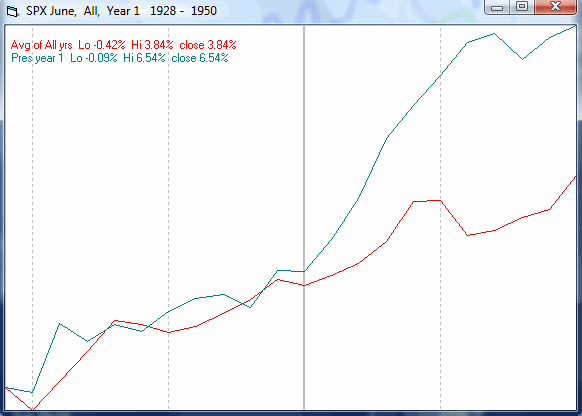
The next chart does the same as the previous chart, but runs from 1950 to 2008 and goes in the opposite direction.
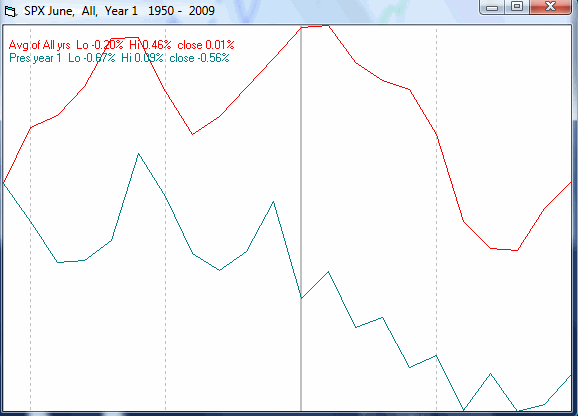
Weak June's have been a phenomena of the last 60 years.
Conclusion
I think there were (are) too many of us looking for a correction in or an end to the recent up move so the final high will be delayed.
I expect the major indices to be higher on Friday June 5 than they were on Friday May 29.
Thank you,
By Mike Burk
To subscribe to this report : http://alphaim.net/signup.html
Gordon Harms produces a Power Point for our local timing group. You can get a copy of that at: http://www.stockmarket-ta.com/ .
Disclaimer: Mike Burk is an employee and principal of Alpha Investment Management (Alpha) a registered investment advisor. Charts and figures presented herein are believed to be reliable but we cannot attest to their accuracy. Recent (last 10-15 yrs.) data has been supplied by CSI (csidata.com), FastTrack (fasttrack.net), Quotes Plus (qp2.com) and the Wall Street Journal (wsj.com). Historical data is from Barron's and ISI price books. The views expressed are provided for information purposes only and should not be construed in any way as investment advice. Furthermore, the opinions expressed may change without notice.
Mike Burk Archive |
© 2005-2022 http://www.MarketOracle.co.uk - The Market Oracle is a FREE Daily Financial Markets Analysis & Forecasting online publication.



